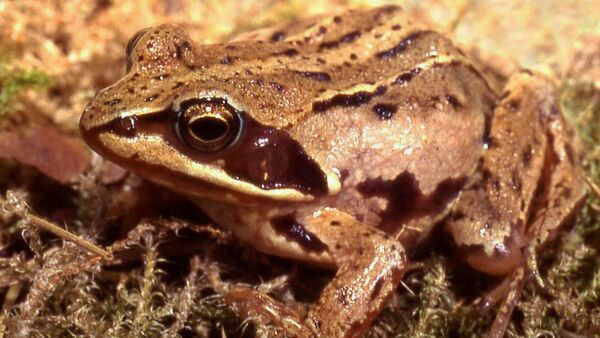According to Roman Polin, a spokesman for the international company Suomen Maastorakentajat Oy, work on the removal of the topsoil began last autumn, but the frogs went into hibernation with the onset of cold weather in October, news outlet Fontanka reported. By order of the Finnish nuclear power company Fennovoima, all work had to be suspended. In May 2016, the sleeping beauties awoke and were honorably moved to a safe location. According to the schedule, the removal of topsoil will be resumed and completed before the end of July 2016, whereupon excavation of soil to the depth of minus 17 meters will begin.
Extensive site work has started for Finland's #Hanhikivi-1. See our special report: https://t.co/KECly5kljG pic.twitter.com/aHWXQBMiSD
— NucNet Nuclear News (@NucNetNews) May 19, 2016
The moor frog (rana arvalis) is a slim, reddish-brown, semi-aquatic amphibian up to seven centimeters in length, which is native to Europe and Asia. The types of landscape they can inhabit are greatly varied. The moor frogs live everywhere from the tundra to the steppes, but prefer areas untouched by humans, such as damp meadows and bogs, but still may be able to live in agricultural and urban areas.
Moor Frog males can turn blue during mating season. pic.twitter.com/HwqJcVO0n8
— Did You Know? (@Know) April 28, 2016
"At present, industry consumes 46 percent of Finland's total energy production. It is therefore clear that renewable energy alone is insufficient to cover the demand. Considering the goal of reducing dependence on the products of the oil and gas industry as well as cutting carbon dioxide emissions, we pay great attention to the development of nuclear energy and the Hanhikivi-1 power plant in particular," Plit said.
The Hanhikivi NPP is scheduled for construction on the Finnish Hanhikivi peninsula, in the municipality of Pyhäjoki. It is to house one Russian-designed VVER-1200 PWR reactor, with a capacity of 1,200 MW. The plant is planned to supply 10 percent of Finland's energy demand by 2024.
Päivän kuva #ydinvoima'n vaarallisuudesta. pic.twitter.com/4YMP94dzgE
— Fennovoima (@Fennovoima) May 6, 2016




